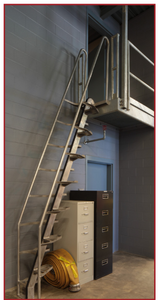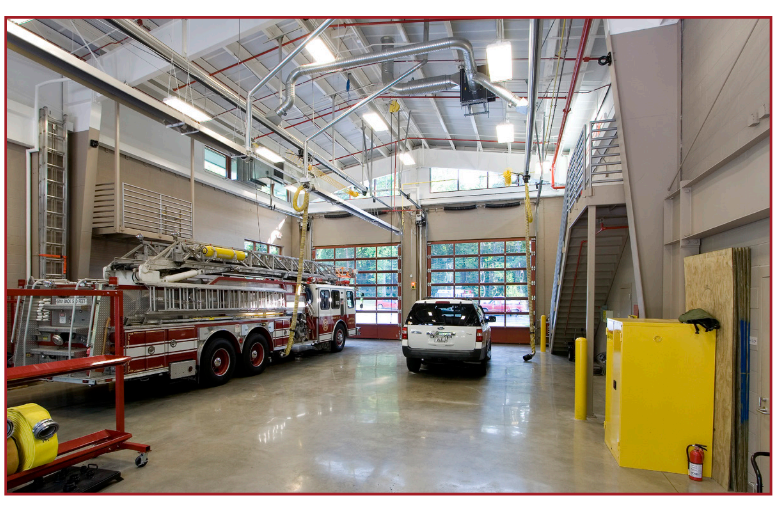
Ken Newell
Have you ever heard anyone say, “We just have too much storage space?” I haven’t either. Whether at home, at the office, or at the station, it seems that our national pastime is collecting “stuff.” Then comes the dilemma of where to keep it all. Unlike much of what we store at our homes, most of what is stored at the station actually has some usefulness and needs to be accessible.
Have you ever heard anyone say, “We just have too much storage space?” I haven’t
either. Whether at home, at the office, or at the station, it seems that our national pastime is collecting “stuff.” Then comes the dilemma of where to keep it all. Unlike much of what we store at our homes, most of what is stored at the station actually has some usefulness and needs to be accessible. Some would look at the station and consider it in the simplest of terms, one large storage facility. You store apparatus, equipment, supplies, and people. Even the building code officially classifies the Apparatus Room as “Storage.” While the station is certainly more complicated than this rudimentary concept, storage is extremely critical to the properly functioning fire house. Inadequate storage causes problems with station maintenance and housekeeping. If you don’t plan for adequate and
appropriate storage in the station, where will the “stuff” find a home?
That’s right, in the Apparatus Room. Walk onto the bay floor of almost any station in America and you will find it littered with everything from lawn mowers to exercise equipment. As you plan for a new station or renovations to the existing facility, it is imperative to consider all of your storage needs and options. Let us consider just a few of the storage needs in the station and some ideas for solving the space demand.
Apparatus Room: Yes, you do plan to store vehicles and mobile equipment here, but there is much more that will be stored now and in the future. There are two mistakes made in the initial planning of the Apparatus Room that hinders the lifetime usefulness of this space. First is not planning enough space at
the end bays between where the apparatus will be parked and the side walls. Not only is this area a major person circulation path, but this space and those walls are prime real estate for a plethora of equipment and loose items such as racks, lockers, cabinets, compressors, gear, etc. The second deficiency is the space between apparatus bays.
Again, the space between parked vehicles will serve as circulation and staging that requires enough room for both when the vehicle doors are open but will also likely be utilized for storage of small equipment, lockers, cabinets and other items.
APPARATUS SUPPORT SPACES:
PPE Room: Besides the obvious turn-out gear lockers or racks, plan the space for benches, shelves, cabinets, and other equipment that will be used.
Tool Shop: There will be one or more workbenches. Keep in mind that you will want to consider space and storage for the tool boxes, cabinets, shelving and flammable material cabinet.
Compressor Room: It’s not just for the compressor. Determine the need for bottle and pack storage racks, along with SCBA repair equipment and supplies.
EMS Storage: From the smallest 3’x4’ closet, to a large room filled with shelving and racks,
don’t forget to condition the air based on what you are storing. Most departments don’t store medications here, but multiple levels of security are needed if you do.
Outside Equipment: Even if you don’t provide your own lawn care and yard maintenance, you may have to do so at some point in the life of the station. Plan a room with easy access to the outside for storing mowers, blowers and all the
things that are needed for outside care.
General Storage: It is always a good idea to have an un-designated room adjacent to the
Apparatus Room for any other type storage needs now and the future. History has proven
that it eventually will be used.
Mezzanine Storage: Mezzanines are a great place to store things that do not require regular access. Reserve hoses and gear, archive files, replacement parts, and even the station’s Christmas decorations can find an out of the way home in the Mezzanine, as long as there is easy access to it.
Offices: Many of the storage needs in each office will be satisfied with desk drawers, shelving and book cases, but including a small closet in each office makes a great place for coats, a change of clothes, and even office supplies.
Training/Community Room: The larger this room is, the more support storage spaces it will need. A storage room large enough to store racks of tables and chairs is needed, along with a separate storage room for audio-visual equipment and aids. A separate closet for training supplies is often desirable. If the room serves as a secondary EOC, an adequate storage room for related equipment should be provided.
Library/Study: Even if there is not a room dedicated to this activity, there will need to be somewhere to keep study and reference materials. It can be one or more rooms with bookcases, cabinet or shelving alcoves along private corridors, or individual study carrels located in quite areas of the station.
Dayroom: Large screen TV and recliners, right? Don’t forget all of the media and gaming storage. You can plan for it from the beginning or live with the unattractive storage racks later.
Kitchen: The potential storage needs in the kitchen is a whole article in itself. Think through your specific storage needs, which are greatly impacted by the type of department you are; career, volunteer, or combination. Volunteers tend to have storage
needs based on large events. Career tends to have storage needs based on separate
supplies for individual shifts. Having at least three separate sets of food lockers, or walk-in pantries can work with either department type.
Vending: Even if you don’t have vending machines now, you will likely have them sometime in the lifespan of the station. If you don’t plan for where they will be located,
they will end up in the Apparatus Room…like everything else you don’t plan for. Try
to locate them where everyone that should have access to them can easily do so without
violating a private or secure space.
Bunkroom: No matter how your department combines or segregates sleepers, this is one
area that seems to always have storage issues. Consider beds that have storage compartments beneath them, or at least that have enough clearance beneath them for storage containers. If you have large lockers or wardrobe cabinets with open, flat tops, assume that your occupants will put storage containers on top of them. If you don’t want the lockers or cabinets to have containers stored on top of them, you should specify slope the tops of them, or at least make the wardrobes ceiling height.
Physical Training: Most of the exercise equipment will remain in place for this space, but there is often varying sizes of support items that should be stored when not in use. Providing closets, or at least shelving, to accommodate mats, balls, towels, water, etc. is
important so that the room does not stay cluttered, and even dangerous.
Residential Laundry: Besides the washer and dryer, you will need plenty of storage space for laundry supplies and related needs. Base cabinets with counter tops for folding, and upper cabinets are beneficial. This area is also a great place to store clean linens and towels for station use.
Janitorial: Janitorial and cleaning supplies always take more space than anticipated. Couple that with the large quantities of paper and housekeeping goods that stations tend to keep on hand and the storage needs grow significantly. Storage space is also needed for cleaning equipment such as vacuums, buffers, buckets, etc. If the station is of any size, consideration should be given for a large, janitorial supply space, and smaller janitorial closets for supply distribution throughout the building.
These are just a few of the less recognized storage needs that occur within the common spaces of the station. With construction costs continuously on the rise, over-building is not affordable, but planning for current and future storage needs is critical. After all, it will be even more expensive to build the needed space later. Plan wisely and incorporate design team members who have experience in efficient station design.



















